1-D Vertical Flux Dynamics in a Low-Gradient Stream: An Assessment of Stage as a Control of Vertical Hyporheic Exchange
Abstract
1. Introduction
2. Materials and Methods
2.1. Study Site: Little Kickapoo Creek
2.2. Data Collection
2.3. Flux Calculations
2.4. Statistics: Stage and Vertical 1-D Flux
3. Results
3.1. Trends in Raw Temperature Data and Vertical 1-D Flux
3.2. Correlation of Stage and 1-D Flux
4. Discussion
4.1. Low-Gradient Stream Conceptual Model—Temperature and Flux dynamics
4.2. Stage as a Control of 1-D Vertical Flux
5. Conclusions
Author Contributions
Funding
Conflicts of Interest
References
- Stallman, R.W. Steady One-Dimensional Fluid Flow in a Semi-Infinite Porous Medium with Sinusoidal Surface Temperature. J. Geophys. Res. 1965, 70, 2821–2827. [Google Scholar] [CrossRef]
- Suzuki, S. Percolation measurements based on heat flow through soil with special reference to paddy fields. J. Geophys. Res. 1960, 65, 2883–2885. [Google Scholar] [CrossRef]
- Conant, B., Jr. Delineating and quantifying ground water discharge zones using streambed temperatures. Ground Water 2004, 42, 243–257. [Google Scholar] [CrossRef] [PubMed]
- Silliman, S.E.; Booth, D.F. Analysis of time-series measurements of sediment temperature for identification of gaining vs. losing portions of Juday Creek, Indiana. J. Hydrol. 1993, 146, 131–148. [Google Scholar] [CrossRef]
- Keery, J.; Binleya, A.; Crook, N.; Smith, J.W.N. Temporal and spatial variability of groundwater–surface water fluxes: Development and application of an analytical method using temperature time series. J. Hydrol. 2007, 336, 1–16. [Google Scholar] [CrossRef]
- Schmidt, C.; Conant, B., Jr.; Bayer-Raich, M.; Schirmer, M. Evaluation and field-scale application of a simple analytical method to quantify groundwater discharge using mapped streambed temperatures. J. Hydrol. 2007, 347, 292–307. [Google Scholar] [CrossRef]
- Hatch, C.E.; Fisher, A.T.; Revenaugh, J.S.; Constantz, J.; Ruehl, C. Quantifying surface water-groundwater interactions using time series analysis of streambed thermal records: Method development. Water Resour. Res. 2006, 42. [Google Scholar] [CrossRef]
- Becker, M.W.; Georgian, T.; Ambrose, H.; Siniscalchi, J.; Fredrick, K. Estimating flow and flux of ground water discharge using water temperature and velocity. J. Hydrol. 2004, 296, 221–233. [Google Scholar] [CrossRef]
- Lapham, W.W. Use of Temperature Profiles Beneath Streams to Determine Rates of Vertical Ground-Water Flow and Vertical Hydraulic Conductivity; 0886-9308; United States Geological Survey: Reston, VA, USA, 1989; p. 35. [Google Scholar]
- Briggs, M.A.; Lautz, L.K.; Buckley, S.F.; Lane, J.W. Practical limitations on the use of diurnal temperature signals to quantify groundwater upwelling. J. Hydrol. 2014, 519, 1739–1751. [Google Scholar] [CrossRef]
- Jensen, J.K.; Engesgaard, P. Nonuniform Groundwater Discharge across a Streambed: Heat as a Tracer. Vadose Zone J. 2011, 10, 98–109. [Google Scholar] [CrossRef]
- Allander, K. Trout Creek—Evaluating ground-water and surface water exchange along an alpine stream, Lake Tahoe, California. In Heat as a Tool for Studying the Movement of Ground Water Near Streams; Stonestrom, D.A., Constantz, J., Eds.; United States Geological Survey: Reston, VA, USA, 2003; Volume Circular 1260, pp. 35–45. [Google Scholar]
- Luce, C.H.; Tonina, D.; Gariglio, F.; Applebee, R. Solutions for the diurnally forced advection-diffusion equation to estimate bulk fluid velocity and diffusivity in streambeds from temperature time series. Water Resour. Res. 2013, 49, 488–506. [Google Scholar] [CrossRef]
- McCallum, A.M.; Andersen, M.S.; Rau, G.C.; Acworth, R.I. A 1-D analytical method for estimating surface water–groundwater interactions and effective thermal diffusivity using temperature time series. Water Resour. Res. 2012, 48. [Google Scholar] [CrossRef]
- Anderson, M.P. Heat as a ground water tracer. Ground Water 2005, 43, 951–968. [Google Scholar] [CrossRef] [PubMed]
- Goto, S.; Yamano, M.; Kinoshita, M. Thermal response of sediment with vertical fluid flow to periodic temperature variation at the surface. J. Geophys. Res. Sol. Earth 2005, 110. [Google Scholar] [CrossRef]
- Young, P.C.; Pedregal, D.J.; Tych, W. Dynamic harmonic regression. J. Forecast. 1999, 18, 369–394. [Google Scholar] [CrossRef]
- Swanson, T.E.; Cardenas, M.B. Ex-Stream: A MATLAB program for calculating fluid flux through sediment–water interfaces based on steady and transient temperature profiles. Comput. Geosci. 2011, 37, 1664–1669. [Google Scholar] [CrossRef]
- Gordon, R.P.; Lautz, L.K.; Briggs, M.A.; McKenzie, J.M. Automated calculation of vertical pore-water flux from field temperature time series using the VFLUX method and computer program. J. Hydrol. 2012, 420, 142–158. [Google Scholar] [CrossRef]
- Irvine, D.J.; Lautz, L.K.; Briggs, M.A.; Gordon, R.P.; McKenzie, J.M. Experimental evaluation of the applicability of phase, amplitude, and combined methods to determine water flux and thermal diffusivity from temperature time series using VFLUX 2. J. Hydrol. 2015, 531, 728–737. [Google Scholar] [CrossRef]
- Ward, A.S.; Fitzgerald, M.; Gooseff, M.N.; Voltz, T.J.; Binley, A.M.; Singha, K. Hydrologic and geomorphic controls on hyporheic exchange during base flow recession in a headwater mountain stream. Water Resour. Res. 2012, 48. [Google Scholar] [CrossRef]
- Ward, A.S.; Schmadel, N.M.; Wondzell, S.M.; Gooseff, M.N.; Singha, K. Dynamic hyporheic and riparian flow path geometry through base flow recession in two headwater mountain stream corridors. Water Resour. Res. 2017, 53, 3988–4003. [Google Scholar] [CrossRef]
- Ward, A.S.; Schmadel, N.M.; Wondzell, S.M.; Harman, C.; Gooseff, M.N.; Singha, K. Hydrogeomorphic controls on hyporheic and riparian transport in two headwater mountain streams during base flow recession. Water Resour. Res. 2016, 52, 1479–1497. [Google Scholar] [CrossRef]
- Schmadel, N.M.; Ward, A.S.; Wondzell, S.M. Hydrologic controls on hyporheic exchange in a headwater mountain stream. Water Resour. Res. 2017, 53, 6260–6278. [Google Scholar] [CrossRef]
- Sickbert, T.B.; Peterson, E.W. The effect of surface water velocity on hyporheic interchange. J. Water Resour. Prot. 2014, 6, 327–336. [Google Scholar] [CrossRef]
- Harvey, J.W.; Bencala, K.E. The effect of streambed topography on surface-subsurface water exchange in mountain catchments. Water Resour. Res. 1993, 29, 89–98. [Google Scholar] [CrossRef]
- Kasahara, T.; Wondzell, S.M. Geomorphic controls on hyporheic exchange flow in mountain streams. Water Resour. Res. 2003, 39. [Google Scholar] [CrossRef]
- Storey, R.G.; Howard, K.W.F.; Williams, D.D. Factors controlling riffle-scale hyporheic exchange flows and their seasonal changes in a gaining stream; a three-dimensional groundwater flow model. Water Resour. Res. 2003, 39. [Google Scholar] [CrossRef]
- Wondzell, S.M.; Gooseff, M.N. Geomorphic controls on hyporheic exchange across scales: Watersheds to particles. In Treatise on Geomorphology; Shroder, J., Wohl, E., Eds.; Academic Press: San Diego, CA, USA, 2013; Volume 9, pp. 203–218. [Google Scholar]
- Cardenas, M.B.; Wilson, J.L.; Zlotnik, V.A. Impact of heterogeneity, bed forms, and stream curvature on subchannel hyporheic exchange. Water Resour. Res. 2004, 40. [Google Scholar] [CrossRef]
- Deming, D. Introduction to Hydrogeology; McGraw-Hill College: New York, NY, USA, 2002; p. 468. [Google Scholar]
- Bastola, H.; Peterson, E.W. Heat tracing to examine seasonal groundwater flow beneath a low-gradient stream. Hydrogeol. J. 2016, 24, 181–194. [Google Scholar] [CrossRef]
- Buyck, M.S. Tracking Nitrate Loss and Modeling Flow through the Hyporheic Zone of a Low Gradient Stream through the Use of Conservative Tracers. Master’s Thesis, Illinois State University, Normal, IL, USA, 2005. [Google Scholar]
- Peterson, E.W.; Hayden, K.M. Transport and Fate of Nitrate in the Streambed of a Low-Gradient Stream. Hydrology 2018, 5, 55. [Google Scholar] [CrossRef]
- Oware, E. The Impact of Storm on Thermal Transport in the Hyporheic Zone of a Low-Gradient Third-Order Sand and Gravel Bedded Stream. Master’s Thesis, Illinois State University, Normal, IL, USA, 2010. [Google Scholar]
- Peterson, E.W.; Sickbert, T.B.; Moore, S.L. High frequency stream bed mobility of a low-gradient agricultural stream with implications on the hyporheic zone. Hydrol. Process. 2008, 22, 4239–4248. [Google Scholar] [CrossRef]
- Peterson, E.W.; Sickbert, T.B. Stream water bypass through a meander neck, laterally extending the hyporheic zone. Hydrogeol. J. 2006, 14, 1443–1451. [Google Scholar] [CrossRef]
- Peterson, E.W.; Benning, C. Factors influencing nitrate within a low-gradient agricultural stream. Environ. Earth Sci. 2013, 68, 1233–1245. [Google Scholar] [CrossRef]
- Riggs, M.H.; Abert, C.C. Cumulative sand and gravel thickness in McLean County, Illinois. In Open File Series 1997-01f; Survey, I.S.G., Ed.; Illinois State Geological Survey: Champaign, IL, USA, 1998. [Google Scholar]
- Hansel, A.K.; Johnson, W.H. Wedron and Mason Groups: Lithostratigraphic Reclassification of Deposits of the Wisconsin Episode, Lake Michigan Lobe Area; Bulletin 104; Illinois State Geological Survey: Champaign, IL, USA, 1996; p. 116. [Google Scholar]
- Basu, A. Quantifying N Cycling Between Groundwater and Surface Water Using Numerical Modeling and Mass Flux Calculations. Master’s Thesis, Illinois State University, Normal, IL, USA, 2007. [Google Scholar]
- Ackerman, J.R.; Peterson, E.W.; Van der Hoven, S.; Perry, W. Quantifying nutrient removal from groundwater seepage out of constructed wetlands receiving treated wastewater effluent. Environ. Earth Sci. 2015, 74, 1633–1645. [Google Scholar] [CrossRef]
- Van der Hoven, S.J.; Fromm, N.J.; Peterson, E.W. Quantifying nitrogen cycling beneath a meander of a low gradient, N-impacted, agricultural stream using tracers and numerical modelling. Hydrol. Process. 2008, 22, 1206–1215. [Google Scholar] [CrossRef]
- Young, P.; Taylor, C.; Tych, W.; Pegregal, D.; McKenna, P. The Captain Toolbox. In Centre for Research on Environmental Systems and Statistics; Lancaster University: Bailrigg, UK, 2010. [Google Scholar]
- R Core Team. R: A Language and Environment for Statistical Computing; R Foundation for Statistical Computing: Vienna, Austria, 2013. [Google Scholar]
- Irvine, D.J.; Briggs, M.; Cartwright, I.; Lautz, L. Improved vertical streambed flux estimation using multiple diurnal temperature methods in series. Groundwater 2016, 55, 73–80. [Google Scholar] [CrossRef]
- Irvine, D.J.; Briggs, M.A.; Lautz, L.K.; Gordon, R.P.; McKenzie, J.M.; Cartwright, I. Using Diurnal Temperature Signals to Infer Vertical Groundwater-Surface Water Exchange. Groundwater 2017, 55, 1–17. [Google Scholar] [CrossRef]
- Beach, V.; Peterson, E.W. Variation of hyporheic temperature profiles in a low gradient third-order agricultural stream–A statistical approach. Open J. Mod. Hydrol. 2013, 3, 55–66. [Google Scholar] [CrossRef]
- Hester, E.T.; Doyle, M.W. In-stream geomorphic structures as drivers of hyporheic exchange. Water Resour. Res. 2008, 44. [Google Scholar] [CrossRef]
- Hill, A.R.; Labadia, C.F.; Sanmugadas, K. Hyporheic zone hydrology and nitrogen dynamics in relation to the streambed topography of a N-rich stream. Biogeochemistry 1998, 42, 285–310. [Google Scholar] [CrossRef]

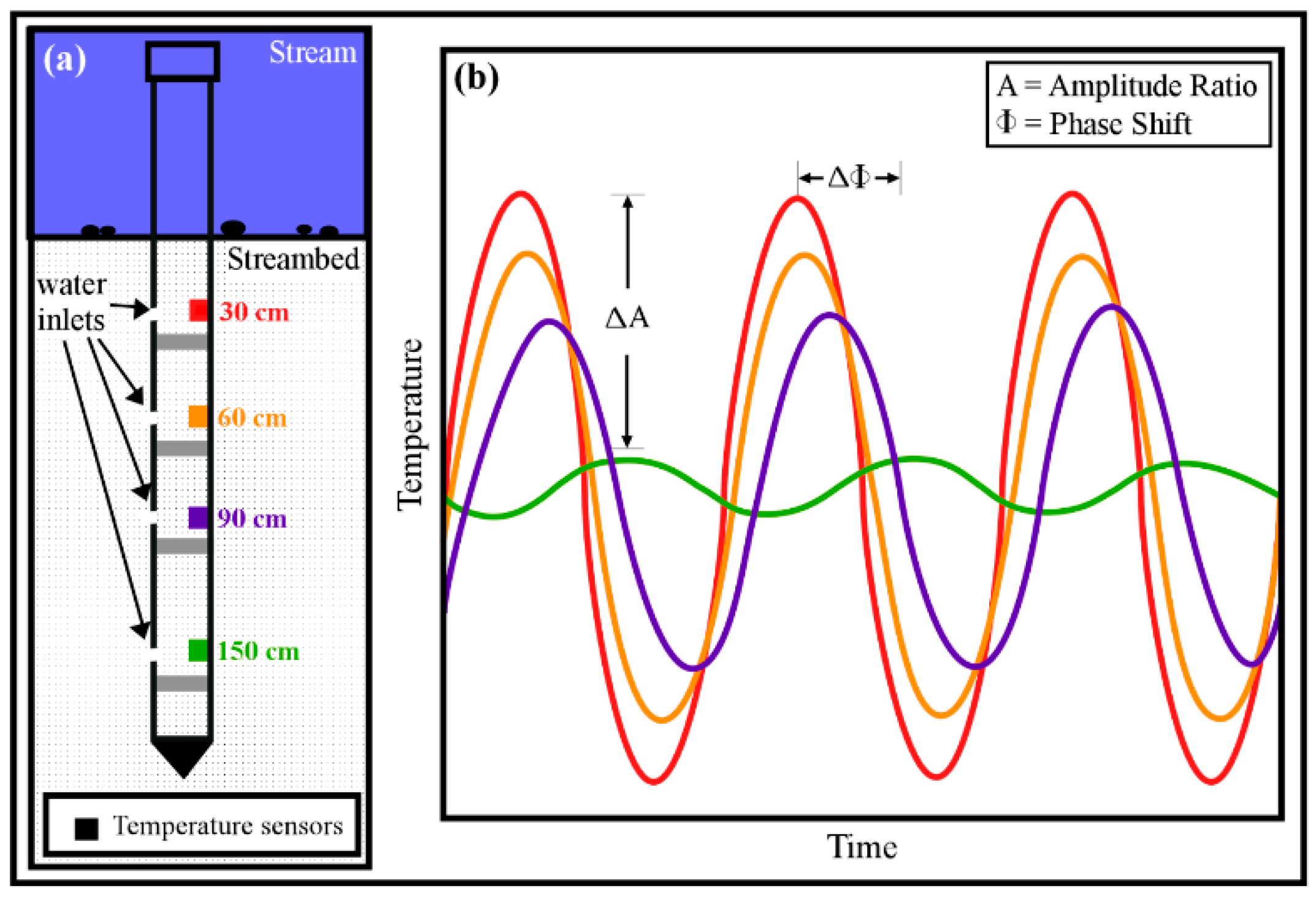
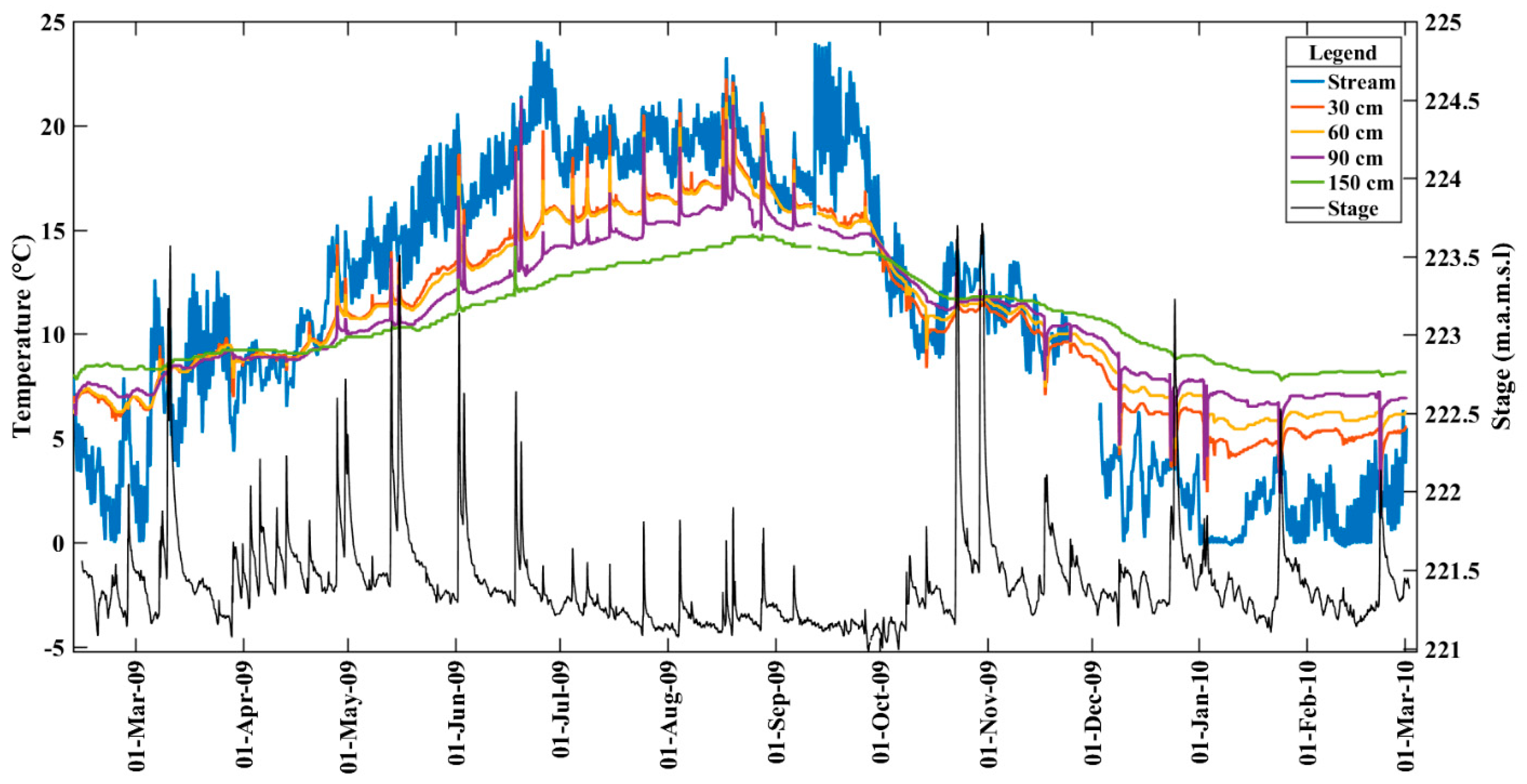
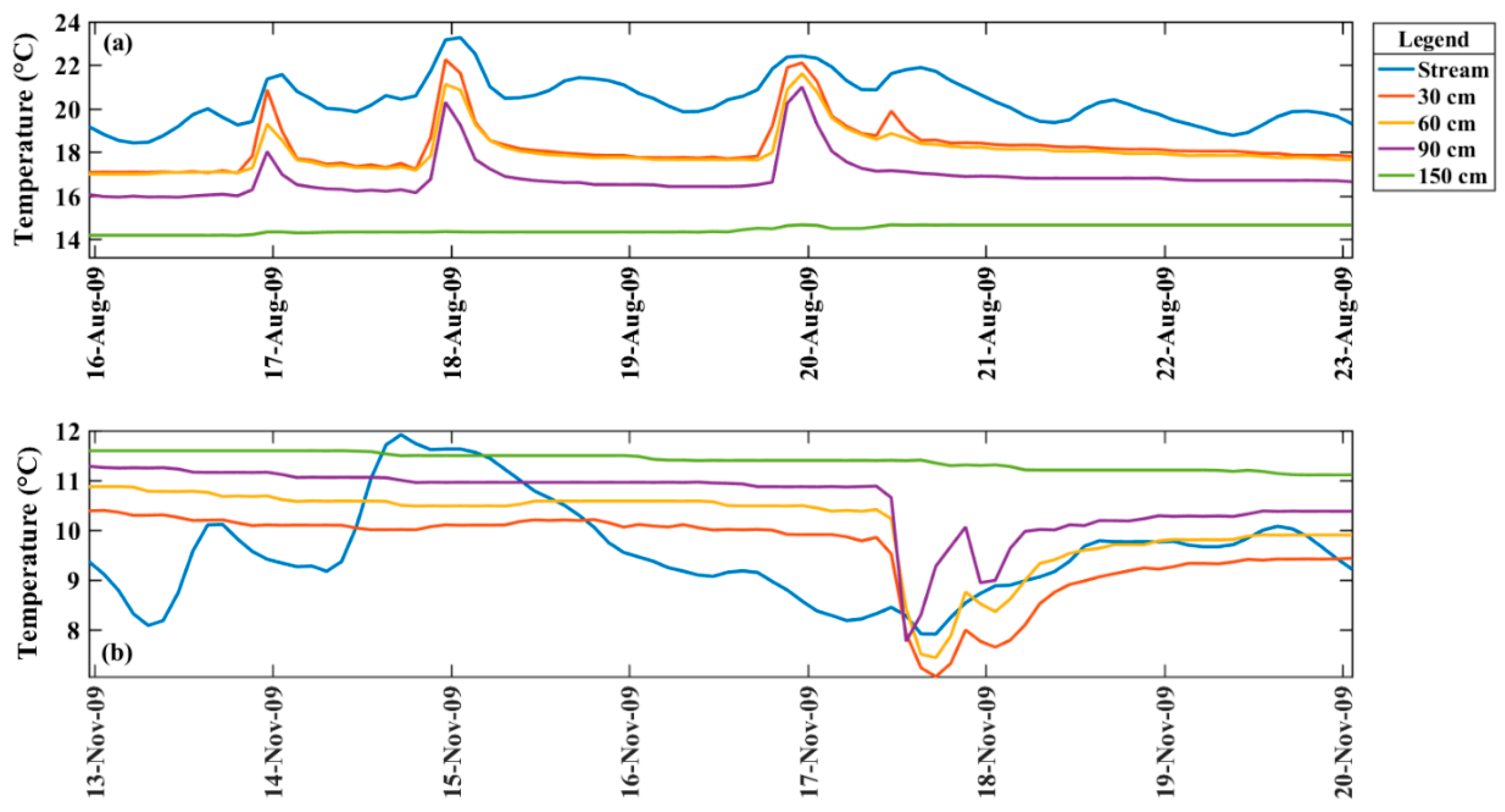
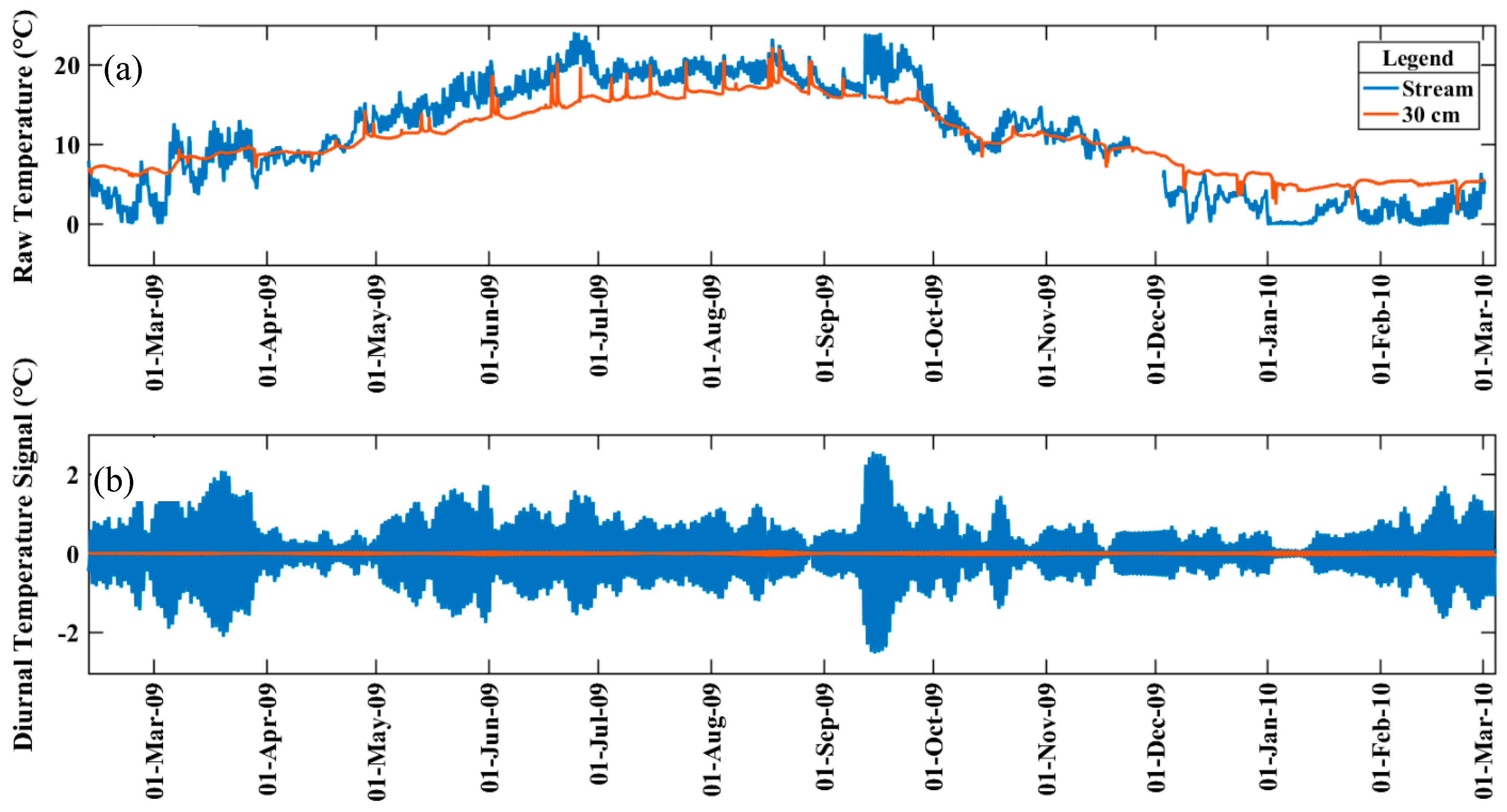
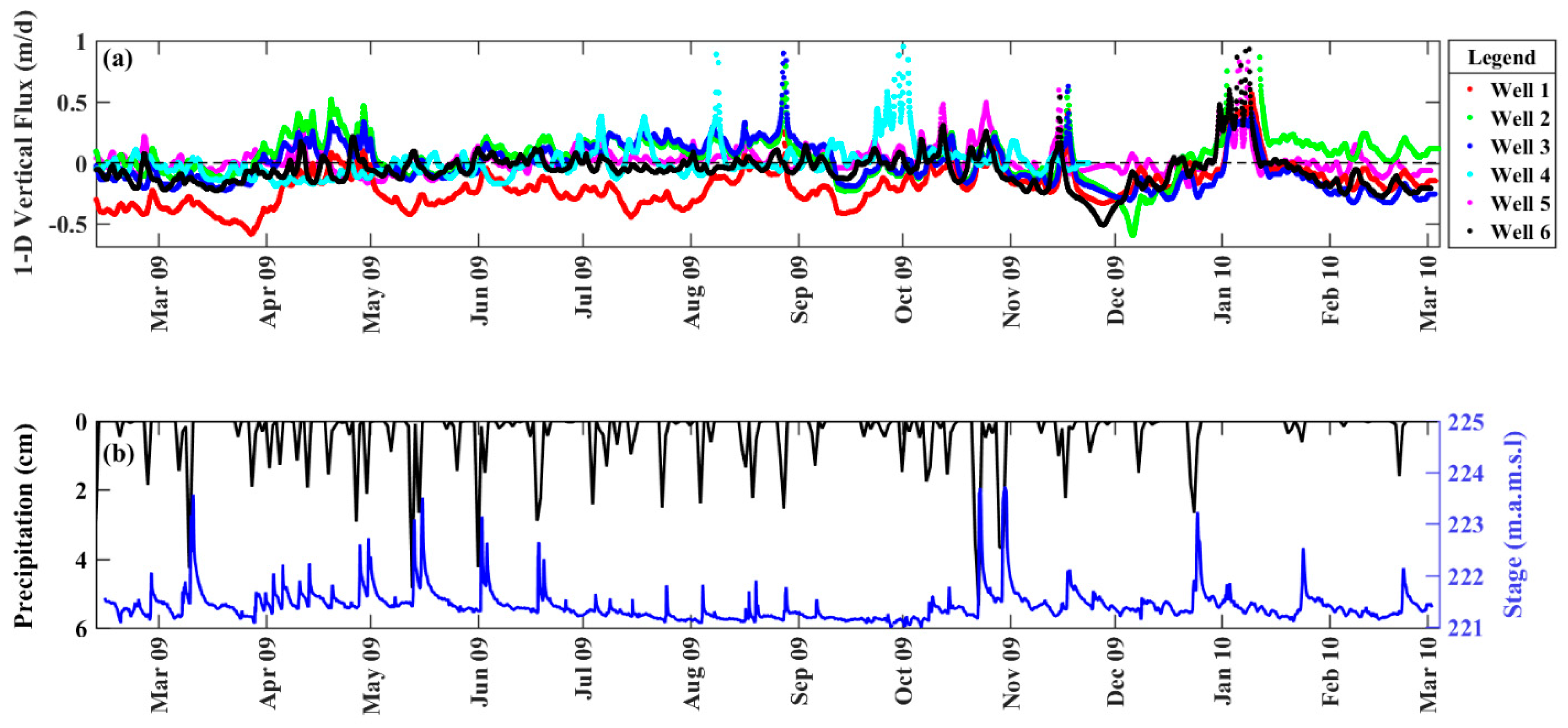
| Parameter | Units | Value | Source |
|---|---|---|---|
| Porosity (n) | 0.375 | [32] | |
| Dispersivity (β) | m | 0.005 | [32] |
| Thermal Conductivity (λo) | cal/sec-cm-C | 0.0033 | [32] |
| Volumetric Heat Capacity of Sediment (Cs) | cal/cm3-C | 0.239 | [32] |
| Volumetric Heat Capacity of Water (Cw) | cal/cm3-C | 1 | [9] |
| Complete Time Series | Winter 2009 | Spring 2009 | Summer 2009 | Fall 2009 | Winter 2010 | |||
|---|---|---|---|---|---|---|---|---|
| Depth | Minimum | Mean | Maximum | Mean | Mean | Mean | Mean | Mean |
| (cm) | (°C) | (°C) | (°C) | (°C) | (°C) | (°C) | (°C) | (°C) |
| Stream (0) | 0.02 | 0.85 | 2.59 | 0.86 | 0.91 | 0.99 | 0.60 | 0.62 |
| 30 | 0.00 | 0.03 | 0.07 | 0.01 | 0.02 | 0.03 | 0.03 | 0.04 |
| 60 | 0.00 | 0.02 | 0.05 | 0.01 | 0.01 | 0.02 | 0.03 | 0.03 |
| 90 | 0.00 | 0.02 | 0.13 | 0.01 | 0.00 | 0.02 | 0.01 | 0.06 |
| 150 | 0.00 | 0.00 | 0.00 | 0.00 | 0.00 | 0.00 | 0.00 | 0.00 |
| Well 1 | Well 2 | Well 3 | Well 4 | Well 5 | Well 6 | |||||||
|---|---|---|---|---|---|---|---|---|---|---|---|---|
| Lag (h) | ρ | Lag (h) | ρ | Lag (h) | ρ | Lag (h) | ρ | Lag (h) | ρ | Lag (h) | ρ | |
| No Lag | 0 | 0.14 | 0 | 0.05 | 0 | 0.09 | 0 | 0.37 | 0 | −0.11 | 0 | −0.03 |
| ρmax | 34 | 0.19 | 26 | 0.09 | 80 | −0.12 | 28 | 0.44 | 80 | −0.18 | 80 | 0.04 |
© 2020 by the authors. Licensee MDPI, Basel, Switzerland. This article is an open access article distributed under the terms and conditions of the Creative Commons Attribution (CC BY) license (http://creativecommons.org/licenses/by/4.0/).
Share and Cite
Harris, F.C.; Peterson, E.W. 1-D Vertical Flux Dynamics in a Low-Gradient Stream: An Assessment of Stage as a Control of Vertical Hyporheic Exchange. Water 2020, 12, 708. https://doi.org/10.3390/w12030708
Harris FC, Peterson EW. 1-D Vertical Flux Dynamics in a Low-Gradient Stream: An Assessment of Stage as a Control of Vertical Hyporheic Exchange. Water. 2020; 12(3):708. https://doi.org/10.3390/w12030708
Chicago/Turabian StyleHarris, F. Claire, and Eric W. Peterson. 2020. "1-D Vertical Flux Dynamics in a Low-Gradient Stream: An Assessment of Stage as a Control of Vertical Hyporheic Exchange" Water 12, no. 3: 708. https://doi.org/10.3390/w12030708
APA StyleHarris, F. C., & Peterson, E. W. (2020). 1-D Vertical Flux Dynamics in a Low-Gradient Stream: An Assessment of Stage as a Control of Vertical Hyporheic Exchange. Water, 12(3), 708. https://doi.org/10.3390/w12030708





